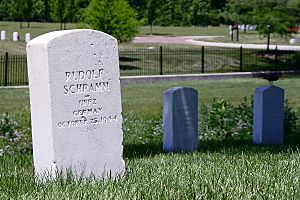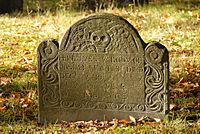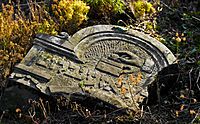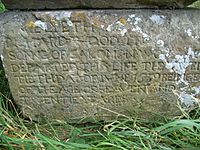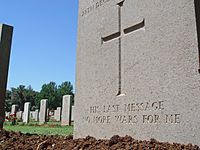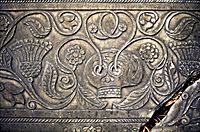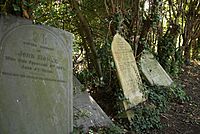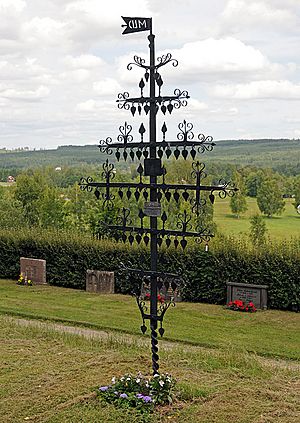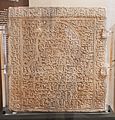Headstone facts for kids
A headstone, gravestone or tombstone is a marker, normally made from stone, that is used to identify the person that is buried beneath it (in the grave).
These markers can be plain or beautifully carved with writing (inscriptions) and pictures.
Materials
A cemetery may follow national codes of practice or independently prescribe the size and use of certain materials, especially in a conservation area. Some may limit the placing of a wooden memorial to six months after burial, after which a more permanent memorial must be placed. Others may require stones of a certain shape or position to facilitate grass-cutting. Headstones of granite, marble and other kinds of stone are usually created, installed, and repaired by monumental masons. Cemeteries require regular inspection and maintenance, as stones may settle, topple and, on rare occasions, fall and injure people; or graves may simply become overgrown and their markers lost or vandalised.
Restoration is a specialized job for a monumental mason. Even overgrowth removal requires care to avoid damaging the carving. For example, ivy should only be cut at the base roots and left to naturally die off, never pulled off forcefully. Many materials have been used as markers.
Stone
- Fieldstones. The earliest markers for graves were natural fieldstone, some unmarked and others decorated or incised using a metal awl. Typical motifs for the carving included a symbol and the deceased's name and age.
- Granite. Granite is a hard stone and requires skill to carve by hand. Modern methods of carving include using computer-controlled rotary bits and sandblasting over a rubber stencil. Leaving the letters, numbers and emblems exposed on the stone, the blaster can create virtually any kind of artwork or epitaph.
- Marble and limestone. Both limestone and marble take carving well. Marble is a recrystallised form of limestone. The mild acid in rainwater can slowly dissolve marble and limestone over time, which can make inscriptions unreadable. Portland stone was a type of limestone commonly used in England—after weathering, fossiliferous deposits tend to appear on the surface. Marble became popular from the early 19th century, though its extra cost limited its appeal.
- Sandstone. Sandstone is durable, yet soft enough to carve easily. Some sandstone markers are so well preserved that individual chisel marks are discernible, while others have delaminated and crumbled to dust. Delamination occurs when moisture gets between the layers of the sandstone. As it freezes and expands the layers flake off. In the 17th century, sandstone replaced field stones in Colonial America. Yorkstone was a common sandstone material used in England.
- Slate. Slate can have a pleasing texture but is slightly porous and prone to delamination. It takes lettering well, often highlighted with white paint or gilding.
-
Granite gravestone of Josiah Leavitt (1679–1717), Hingham Center Cemetery, Hingham, Plymouth County, Massachusetts
-
HIS LAST MESSAGE: NO MORE WARS FOR ME—A headstone in the Jerusalem British World War I Cemetery on Mount Scopus
-
Elaborately carved grave slab at Shebbear (Devon, England) showing a skull sprouting flowering shoots, as a symbol of resurrection
Metal, wood and plants
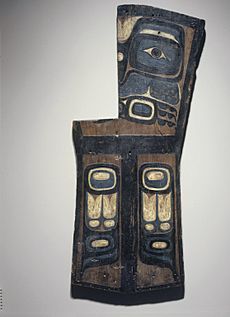
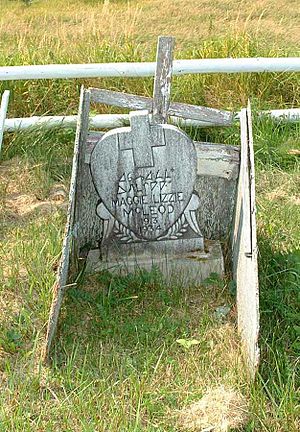
- Iron. Iron grave markers and decorations were popular during the Victorian era in the United Kingdom and elsewhere, often being produced by specialist foundries or the local blacksmith. Cast iron headstones have lasted for generations while wrought ironwork often only survives in a rusted or eroded state. In eastern Värmland, Sweden, iron crosses instead of stones have been popular since the 18th century.
- White bronze. Actually sand cast zinc, but called white bronze for marketing purposes. Almost all, if not all, zinc grave markers were made by the Monumental Bronze Company of Bridgeport, CT, between 1874 and 1914. They are in cemeteries of the period all across the U.S. and Canada. They were sold as more durable than marble, about 1/3 less expensive and progressive.
- Wood. This was a popular material during the Georgian and Victorian era, and almost certainly before, in Great Britain and elsewhere. Some could be very ornate, although few survive beyond 50–100 years due to natural decomposition.
- Planting. Trees or shrubs, particularly roses, may be planted, especially to mark the location of ashes. This may be accompanied by a small inscribed metal or wooden marker.
Images for kids
-
Captain Andrew Drake (1684–1743) sandstone gravestone from the Stelton Baptist Church Edison, New Jersey
-
Marble headstone of a couple buried together in Singapore, showing an arched emblem, signifying the reunification with one's partner in heaven. Within the arch is a statue of Jesus Christ
-
A tombstone at the grave of Paavo Ruotsalainen (1777–1852) in Nilsiä, Kuopio, Finland
-
Gravestone in Canada with indigenous language inscription in Canadian Aboriginal Syllabics
-
Hebrew inscriptions on gravestones in Sobědruhy.
-
Serbian women's stone in Gornja Gorevnica, Serbia.
-
An equestrian motif on an 11th-century Swedish gravestone.
-
Islamic cemetery in Sarajevo, with columnar headstones
-
Typical late-20th-century headstone, Dubuque, Iowa
-
Headstone for a dog, Tatton Park, Cheshire, England
-
Unconventional tombstone in the Cemetery Park of the "Freireligiöse Gemeinde" in Berlin, Prenzlauer Berg. Tree stump headstones in U.S. cemeteries are often associated with fraternal organization Woodmen of the World
-
A late-19th-century headstone adorned with the Masonic square and compass
-
Tombstone topped with orb symbolizing a celestial body and the reward of resurrection, churchyard of St. Peter's Church in the Great Valley, Malvern, Chester County, Pennsylvania
-
Personalized gravestone inscription, Berwick, PA
See also
 In Spanish: Lápida para niños
In Spanish: Lápida para niños


